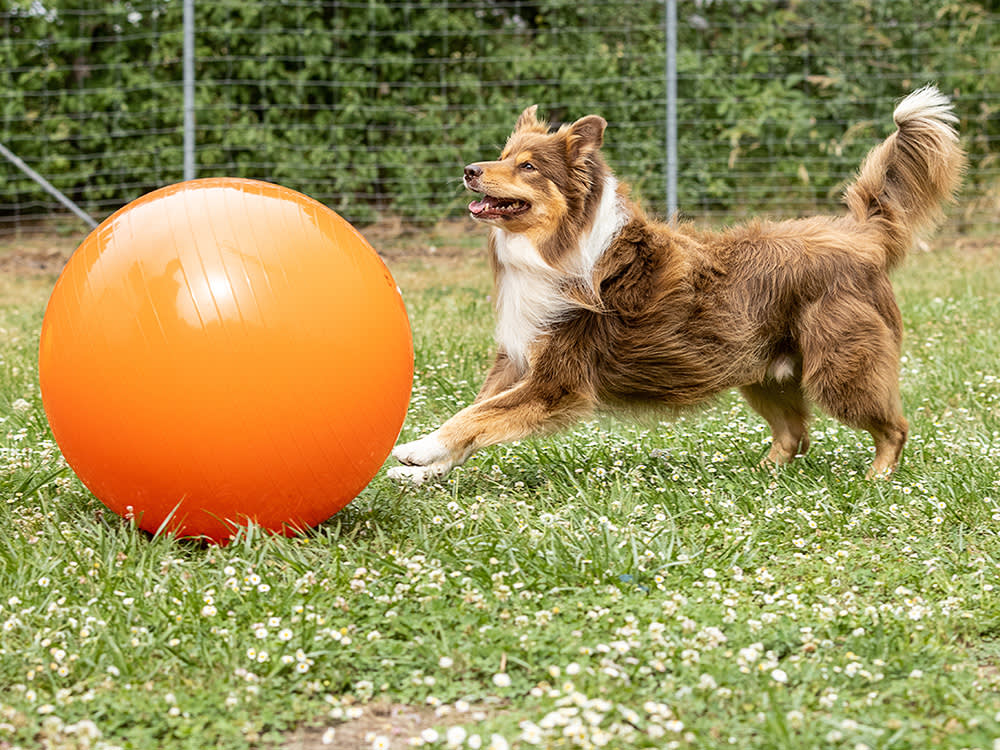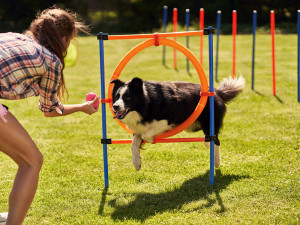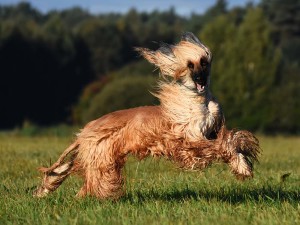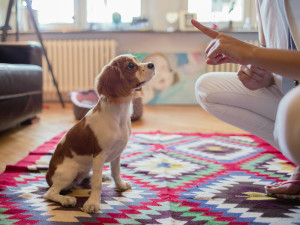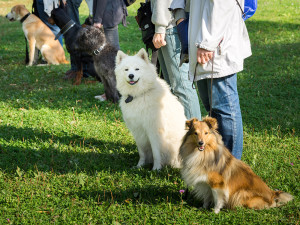“Urban Herding” Can Burn Your Dog’s Energy
If your dog needs a job, trainers recommend Treibball.
Like most dog people, I do not live on a farm, nor do I have livestock, unless you count the chipmunks squatting in my garden. This is the great disappointment of my dog Peach’s life. She’ll herd anything — people, other dogs, even the cats. A Dutch Shepherd mix, no doubt she’d love to be rounding up bad guys.
Short on both sheep and criminals, I eagerly signed us up for a Treibball (pronounced “try ball”) workshop in a suburb of Chicago. Treibball is best described as urban herding: from varying distances, you direct your dog to move large exercise balls into a goal, like herding sheep into a pen. All dogs are welcome to play, regardless of breed or age. While the distance skills and verbal cues are similar to those used in agility, Treibball makes almost no physical demands on the handler, and so people of any age and athletic ability can play.
Where Did Treibball Come From?
Treibball, also known as drive-ball or push ball, originated in Germany in 2005 when Dutch dog trainer Jan Nijboer watched his Australian Cattle Dogs push their rubber water dishes around the field after finishing herding lessons. The dogs, who clearly still had energy to spare, had created their own game. He wondered if they would also push large exercise balls, and found that they easily took to the new “sheep.”
After Nijboer introduced the game to his herding students, it quickly spread across Europe and then to the United States. In 2007, Sweden hosted the inaugural international Treibball competition. American Treibball Association (ATA) founder Dianna Stearns first saw drive-ball videos in 2009. As a positive-reinforcement trainer, she appreciated Nijboer’s emphasis on a respectful relationship between dog and handler. “I could see it being used as a positive teaching tool,” says Stearns. “[It’s] fun, fosters a stronger bond without corrections or punishment, [and] improves communication skills and enhances a dog’s off-leash reliability.
How much do you spend on your pet per year?
Another group, National Association of Treibball Enthusiastsopens in new tab, promotes Treibball as a fun and safe yet challenging sport for all dogs and handlers. Launched in 2010, they endorse “dog-friendly training techniques that support the best qualities of the human/canine relationship.”
How Can Treibball Keep Your Pup Occupied?
“As a trainer and behavior consultant, a lot of the behavior problems I’m asked to address stem from the sad effects of dogs who are bored … who are expected to simply lie [around] while their owners watch TV,” says Stearns. “Most dogs are problem solvers. They need an outlet for their intelligence and energy before it gets funneled into destructive chewing, digging, barking, and fence running.” Stearns has enjoyed the challenge of Treibball with her own dogsopens in new tab including a Border Collie/Aussie mix who, she jokes, is “currently suffering from teenage brain.”
“[My dogs] have different approaches to the balls and to the game,” says Stearns. “I’ve had to adapt my training to each of their different learning styles. Because Treibball is a problem-solving game [in which the handler directs] the dog to go after a specific ball depending on where that ball rolls, both handler and dog must continually correct their positioning. It’s been a major problem-solving exercise in creative thinking and teaching.”
That was certainly the case when Peach and I followed our Treibball instructor’s directions. Since we have competitive agility and disc dog backgrounds, the verbal and physical cues I used were different than those suggested in class. I made some adjustments and decided how to match up cues Peach already knew with the various Treibball maneuvers. Peach took it all in stride, eager to work on “sends” to her mat from 15 feet away and down on command at varying distances, and to target various objects — even a toy dump truck! — in preparation for our first ball.
We both pouted when we realized we wouldn’t get a ball right away, but like any canine sport, it’s important to master foundation skills first. Also, Peach habitually retrieves her target with her mouth, which is frowned upon in Treibball. A dog who bites the ball will be eliminated; driving must be done with the nose only.
Why High-Energy Dogs Are a Good Fit
Treibball is a great solution for high-energy dogs whose pet parents cannot match their activity level. Our sedentary lifestyles are often at odds with the level of high activity that helps dogs thrive. Most dogs would love a job, and a thinking job or game that increases their bond with their person is a natural fit. Whether you pursue Treibball competitively or recreationally, suburban and city dogs will enjoy the physical and mental stimulation of tending to their inflatable ball flock.
